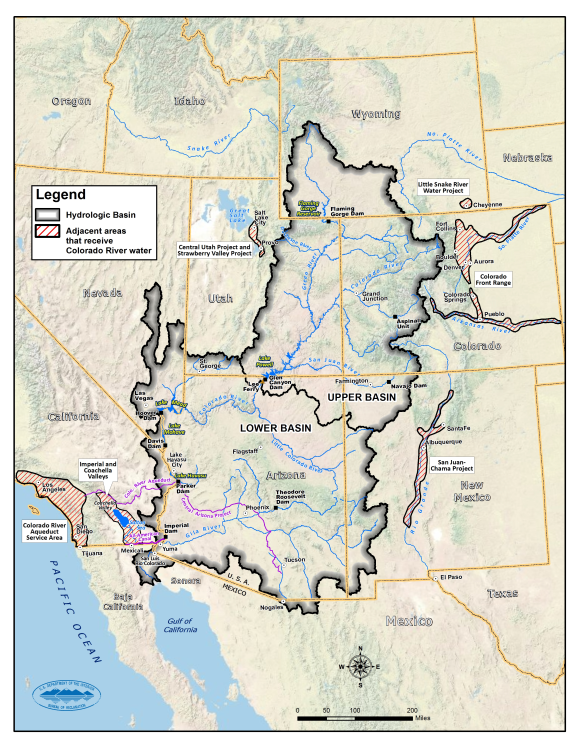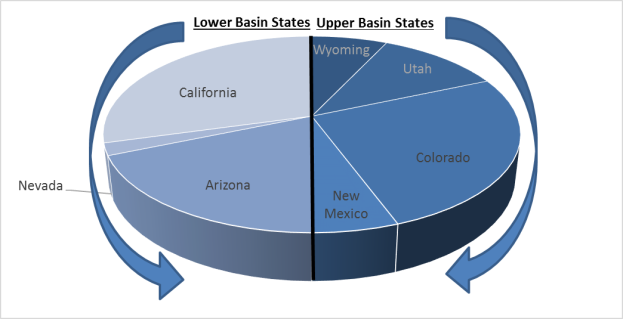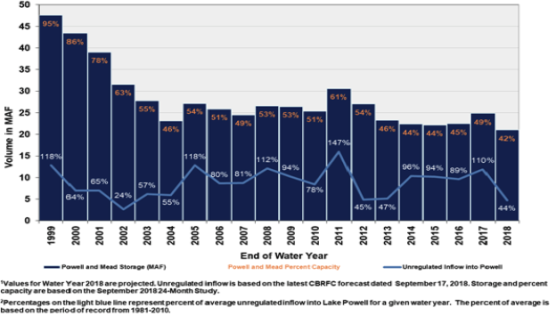Drought Contingency Plans for the Colorado River Basin
The Colorado River Basin is a critical source of water and power supplies for seven western states and Mexico. The basin is in the midst of a long-term drought. Water levels at the basin's two largest reservoirs, Lake Mead and Lake Powell, could reach critically low levels. Building on prior agreements, recently the basin states and the Bureau of Reclamation (Reclamation) transmitted to Congress drought contingency plans (DCPs) that aim to decrease the likelihood of major water and power supply disruptions for users.
Colorado River Basin in Context
The Colorado River Basin (Figure 1) covers approximately 246,000 square miles, 97% of which are in the United States. It includes the Colorado River and its tributaries, which cross the U.S. border into Mexico before discharging into the Gulf of California. Pursuant to federal law, multiple federal facilities (e.g., Hoover Dam) store and convey basin waters and generate hydropower for the southwestern United States. The primary federal agency with jurisdiction over the river is Reclamation, an agency within the Department of the Interior.
 |
|
Source: Bureau of Reclamation. |
Based on observed data, average natural Colorado River flows in the 20th century were about 15 million acre-feet (maf) annually. Flows have dipped during a long-term drought dating to 2000; Reclamation estimated that from 2008 to 2018, flows averaged 12.9 maf.
The Law of the River
The Colorado River Compact of 1922 is the foundation of the "Law of the River," which governs Colorado River water management. Under the compact, water supplies are divided equally between the Upper Basin and the Lower Basin (Figure 2), with the dividing line at Lee Ferry, AZ (near the Utah Border). Congress approved the compact in 1928. State apportionments were established in agreements approved subsequent to the Colorado River Compact, and other laws and court decisions have further added to the Law of the River. Pursuant to a 1944 treaty with Mexico, an additional 1.5 maf per year is reserved for flows to Mexico.
 |
|
Sources: Colorado River Compact of 1922, the Boulder Canyon Project Act, and the Upper Colorado River Basin Compact of 1948. Notes: Assumes Colorado River Compact apportionment of 15 maf (7.5 maf to each basin). Does not reflect 1.5 maf to Mexico under the Mexican Water Treaty of 1944. |
Supply/Demand Imbalance
Consumptive use in the basin typically exceeds natural flows, and studies project this trend will lead to a long-term imbalance in supply and demand. The basin has thus far avoided major impacts due to its significant storage capacity in two lakes (Lake Powell and Lake Mead), coupled with the fact that Upper Basin states have not fully developed their entitlement. However, water in storage is dropping as a result of the drought (Figure 3). Population increases and tribal water rights are likely to further increase demand, and recent studies have concluded that Colorado River flows are unlikely to return to their 20th century averages.
|
Figure 3. Lake Powell and Lake Mead Storage and Inflows (as of fall 2018) |
 |
|
Source: Bureau of Reclamation, 2018. |
Drought Contingency Plans
On March 19, 2019, the basin states signed and transmitted to Congress Upper and Lower Basin Drought Contingency Plans (DCPs) that aim to decrease stress on basin water supplies. They build on a series of prior efforts:
- The 2003 Quantification Settlement Agreement (QSA) provided that California would reduce its California's Colorado River water use to adhere to its water allocations under the Law of the River.
- The 2007 Colorado River Interim Guidelines for Lower Basin Shortages and Coordinated Operations for Lake Powell and Lake Mead included criteria for "balancing" releases between Lakes Powell and Mead and a created a mechanism for storing conserved water in Lake Mead. They also included a schedule of Lower Basin curtailments in Arizona and Nevada if Lake Mead drops to an elevation of 1,075 feet or less (i.e., a "shortage condition"). As of January 2019, there was a 69% chance of a shortage condition beginning in 2020.
- The Pilot System Conservation Program was initiated in 2014 as a DOI-led effort to provide cost-shared funding for projects to conserve water supplies in the Lower Basin. It was reauthorized by Congress in 2018.
- The 2017 Minute 323 agreement with Mexico replaced a previous 2012 agreement (Minute 319) with Mexico. It included increased U.S. storage opportunities for Mexico and a binational plan committing Mexico to new delivery curtailments that would go into effect upon approval of the Lower Basin DCP.
The Upper Basin DCP would establish a Demand Management Program for the Upper Basin by authorizing storage of conserved water in Lake Powell. It also would establish 3,525 feet as the target operational level for Lake Powell and coordinate operations with other Upper Basin reservoirs so as to reduce the risk of Lake Powell's elevation falling below 3,490 feet (a point at which reduced hydropower generation and cutbacks to water users are possible).
The Lower Basin DCP would require that when Lake Mead reaches predetermined elevations, Lower Basin states would forgo deliveries beyond the levels agreed to in 2007 (and includes for the first time cutbacks for California). It would also further incentivize voluntary conservation of water to be stored in Lake Mead and commit DOI to conserving 100,000 acre-feet of water per year to be left in the system. The agreement aims to avoid Lake Mead elevations falling below 1,020 feet.
The DCPs have been approved by all states and most basin contractors. Imperial Irrigation District (a major water rights holder on the Colorado River in Southern California) has refused to approve the Lower Basin DCP without assurances of federal funding for restoration of the Salton Sea.
Before they can be implemented, the DCPs must be authorized by Congress. In a letter transmitting the DCPs to Congress, the basin states requested congressional enactment by April 22, 2019. If the DCPs are not enacted, DOI may choose to make unilateral water delivery cutbacks in the basin.